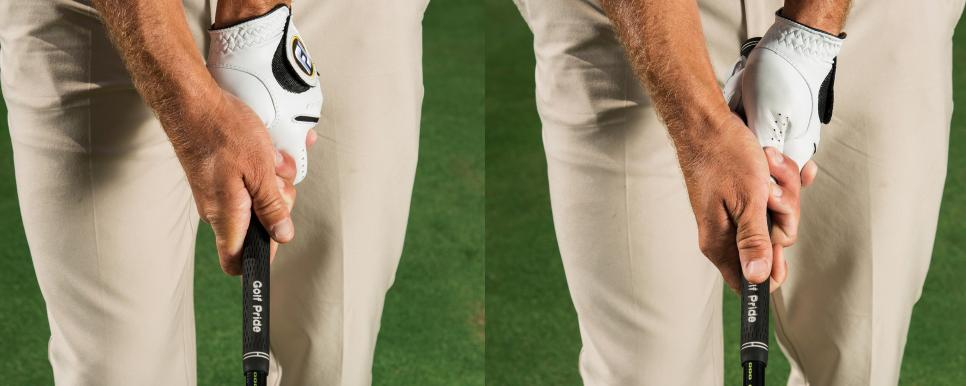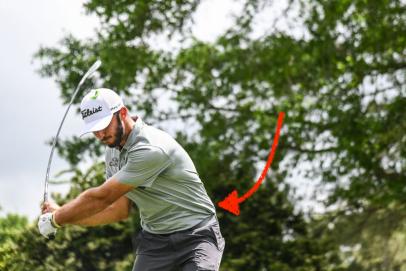Ease the pain
How golfers with back issues should adjust their swings, according to a top tour coach

Getty Images
There are few injuries as debilitating for a golfer as a bad back. Yet given the strain a golf swing can put on the spine, back injuries are among the most common in our game.
Luckily, there are plenty of ways you can take pressure off your back in your swing. To help you play through injury, we consulted Dr. Jim Suttie, a one of Golf Digest's 50 Best Teachers and the 2000 PGA National Teacher of the Year. Not only has Suttie—known by his students as “Doc”—coached 20 tour pros, including Paul Azinger and Larry Mize, but he has a doctorate degree in biomechanics.
Suttie says it’s possible to play with an injured back, but golfers must make a recognition: “It’s going to be a hands-and-arm swing, and the body responds to what the hands and arms do.” In other words, don’t try to emulate the modern swing of tour pros, which often involves a lot of body rotation.
Whether you’re dealing with an ailing back or looking to prolong your golf career, here are Suttie’s eight swing keys to take the stress off your spine.
1. Stand up straighter at address

Padraig Harrington is standing up relatively straight as he addresses the ball.
At address, forget trying to look like Adam Scott, bent way over the ball with a perfectly straight spine. “If you have a bad back, you can’t bend forward as much,” says Suttie, who advocates for standing up straighter. “It’s going to put more weight on the heels, and you’re probably going to be a little closer to the ball,” he says.
2. Turn the upper and lower body together

Notice how Sam Snead has turned his hips in the backswing.
Some believe the backswing should be a coiling motion, where the upper body turns and the lower body stays as still as possible. Suttie says for anyone looking to take pressure off their back, avoid this move.
“You should try to eliminate the coil and think of turning,” he says. “By that I mean you want to get into the old classical motion of turning your hips and shoulders together, to not put any coil into your backswing.”
3. Use a narrow stance with the feet turned out
Having a narrow stance allows the lower body more freedom to turn in the backswing, preventing the dreaded coil that puts stress on the back, Suttie says. Also consider flaring both feet out at address, turning the feet away from each other to further promote lower body rotation in the backswing.
4. Eliminate hip and spine tilt
Suttie says one of the biggest contributing factors to back pain is excessive tilting of the hips and spine throughout the swing. “When you’re bent forward, you’re going to have one hip higher than the other on the backswing, and you’re going to have one hip higher than the other on the forward swing,” he says. This tilting of the hips and spine required to stay in a bent over posture throughout the swing puts a lot of stress on the back.
Instead, Suttie says, “You want to turn as level as you can. You’re going to turn on a flatter plane, not a tilted plane. In other words, your shoulders are going to turn almost like a baseball player.” This is largely created, he says, by standing up taller at address. When you’re not bent over much, your body will turn more level.
5. Move the ball up in your stance
To help you turn more level in the downswing, Suttie says you should play with a ball position more forward than usual. “When you get the ball too far back, you’re going to swing too far from the inside and tilt,” he says. When you swing excessively in-to-out on the downswing, the spine tilts away from the target, putting strain on the back. Putting the ball more forward in the stance will help you keep your trail shoulder higher in the downswing, a key to turning more level through the shot.
6. Weaken your grip

Golfers with back problems should opt for a weaker grip, as shown on the right.
“A weaker grip is certainly a lot better for somebody with a bad back because you’ll use your hands and arms more,” says Suttie. When the hands and arms swing freely, the body has less work to do, making it easier on the back. Consider turning each hand so that the “V” formed by your thumb and forefinger points more toward your chin versus your trail shoulder (above right). This will weaken your grip and allow your hands and arms to swing more.
7. Let the head move
Some players try to keep their head perfectly still in the backswing, in an effort to stay centered over the ball. Suttie says this isn’t necessary: “It’s OK to move your head. Loading into the right leg is a pretty good idea for somebody with a bad back.” Let your head move naturally to the right (for a right-handed player) in the backswing, as you load into your trail leg. If you fail to load properly going back, you risk having a reverse weight shift, where your spine tilts back in the downswing.
8. Minimize leg drive in the downswing
You might have been taught to feel like you’re firing your hips in the downswing to get them open to the target at impact. Though that advice is suitable for many players, if you have back problems, you need to feel like your upper body is doing most of the work on the way down. “It’s more of an upper body swing, a lot like what Moe [Norman] had,” Suttie says. “It’s not a leg-driven swing at all. You don’t want to drive your legs hard because that’s going to create tilt.”
He notes that many tour players drive their legs hard on the downswing, seeking to maximize ground force and thus power. Yet, he warns of that motion putting a lot of stress on the lower back. Instead of aggressively using their legs on the downswing, golfers with bad backs should try to keep their knees bent coming down and through impact, Suttie says. This will slow the rotation of the lower body and prevent the spine from tilting away from the target.







